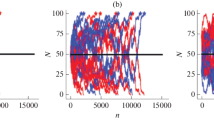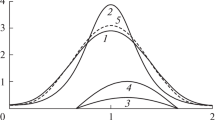Abstract
Self-organized criticality is considered as a threshold stage of autowave self-organization in the evolutionary process. The proposed model defines self-organized criticality as a set of threshold parameters of the autowave system of equations. Consequently, it is associated with the formation of a qualitatively new biological structure (a new species). Experimental data on the mutation rate for groups of mice and unicellular eukaryotes that are published in the scientific literature are used to construct an autowave model of speciation at the population level. This model approach demonstrates compliance with the available experimental data in the process of fixing recessive mutations: there are three stages of fixation of mutations (accumulation of phenotypic differences, the threshold level of the mutation rate, and elimination of mutation carriers) and the maximum mutation rate when the mismatch repair system and the DNA polymerase \(\delta\) proofreading activity are disabled. The percolation model of mutations with a delayed mutation rate is used to analyze the dynamics of the number of mutants in generations. The results demonstrate exact correspondence between the use of autowave model and percolation model of mutation fixation for calculating and analyzing the dynamics of the mutation rate and the number of mutation carriers.




Similar content being viewed by others
REFERENCES
P. Bak, C. Tang, and K. Wiesenfeld, Phys. Rev. A 38, 364 (1988).
R. Tamura, S. Tanaka, and N. Kawashima, in Interface Between Quantum Information and Statistical Physics, Proceedings of the Symposium, Japan, Nov. 10–12, 2011, Vol. 7 of Kinki Univ. Series on Quantum Computing (2012), p. 215.
J. Hesse and T. Gross, Front. Syst. Neurosci. 8, 166 (2014).
C. Meisel, A. Storch, S. Hallmeyer-Elgner, et al., PLoS Comput. Biol. 8, e1002312 (2012).
C. Bédard, H. Kröger, and A. Destexhe, Phys. Rev. Lett. 97 (11) (2006).
H. J. Jensen, Self-Organized Criticality (Cambridge Univ. Press, Cambridge, 1998).
D. Sornette, A. Johansen, and I. Dornic, J. Phys. I (France) 5, 325 (1995).
P. Bak, How Nature Works (Springer, New York, 1996).
M. Bartolozzi, D. B. Leinweber, and A. W. Thomas, Phys. A (Amsterdam, Neth.) 350, 451 (2005).
L. Cocchi, L. L. Gollo, A. Zalesky, and M. Breakspear, Prog. Neurobiol. 158, 132 (2017).
J. M. Beggs and D. Plenz, J. Neurosci. 23, 11167 (2003).
D. Marković and C. Gros, Phys. Rep. 536 (2), 41 (2014).
P. Bak, C. Tang, and K. Wiesenfeld, Phys. Rev. Lett. 59, 381 (1987).
P. Bak, Phys. A (Amsterdam, Neth.) 163, 403 (1990).
Z. Olami, H. J. S. Feder, and K. Christensen, Phys. Rev. Lett. 68, 1244 (1992).
R. Burridge and L. Knopoff, Bull. Seismol. Soc. Am. 57, 341 (1967).
S. Hergarten and H. J. Neugebauer, Phys. Rev. Lett. 88 (23) (2002).
S. Lise and M. Paczuski, Phys. Rev. E 63 (3) (2001).
S. Lise and M. Paczuski, Phys. Rev. E 64 (4) (2001).
L. de Arcangelis, C. Godano, J. R. Grasso, and E. Lippiello, Phys. Rep. 628, 1 (2016).
B. Drossel and F. Schwabl, Phys. Rev. Lett. 69, 1629 (1992).
P. Bak, K. Chen, and C. Tang, Phys. Lett. A 147, 297 (1990).
P. Grassberger and H. Kantz, J. Stat. Phys. 63, 685 (1991).
W. K. Moßner, B. Drossel, and F. Schwabl, Phys. A (Amsterdam, Neth.) 190, 205 (1992).
P. Bak and K. Sneppen, Phys. Rev. Lett. 71, 4083 (1993).
S. J. Gould and N. Eldredge, Paleobiology 3, 115 (1977).
A. V. Podlazov, The Future of Applied Mathematics: Lectures for Young Researchers, Ed. by G.G. Malinetskii (Editorial URSS, Moscow, 2005), pp. 404–426 [in Russian].
P. Bak and M. Paczuski, Lect. Notes Phys. 480, 341 (1997).
A. Uchimura, M. Higuchi, Y. Minakuchi, et al., Genome Res. 25, 1125 (2015).
A. J. Herr, M. Ogawa, N. A. Lawrence, et al., PLoS Genet. 7, e1002282 (2011).
A. J. Herr, S. R. Kennedy, G. M. Knowels, et al., Genetics 196, 677 (2014).
B. Alberts, A. Johnson, J. Lewis, et al., Molecular Biology of the Cell (Garland Science, New York, 2017).
P. M. J. Burgers, J. Biol. Chem. 284, 4041 (2008).
M. J. Prindle and L. A. Loeb, Environ. Mol. Mutagen. 53, 666 (2012).
R. E. Johnson, R. Klassen, L. Prakash, and S. Prakash, Mol. Cell. 59, 163 (2015).
U. Hübscher, G. Maga, and S. Spadari, Ann. Rev. Biochem. 71, 133 (2002).
M. Banach-Orlowska, I. J. Fijalkowska, R. M. Schaaper, and P. Jonczyk, Mol. Microbiol. 58, 61 (2005).
M. Lynch, M. S. Ackerman, J.-F. Gout, et al., Nat. Rev. Genet. 17, 704 (2016).
A. Morrison, A. L. Johnson, L. H. Johnston, and A. Sugino, EMBO J. 12, 1467 (1993).
T. M. Albertson, M. Ogawa, J. M. Bugni, et al., Proc. Natl. Acad. Sci. U. S. A. 106, 17101 (2009).
L. Li, K. M. Murphy, U. Kanevets, L. J. Reha-Krantz, Genetics 170, 569 (2005).
S. A. Nick McElhinny, D. A. Gordenin, C. M. Stith, et al., Mol. Cell. 30, 137 (2008).
C. N. Greene and S. Jinks-Robertson, Genetics 159, 65 (2001).
H. T. Tran, D. A. Gordenin, and M. A. Resnick, Mol. Cell. Biol. 19, 2000 (1999).
I. J. Fijalkowska and R. M. Schaapert, Genetics 93, 2856 (1996).
L. N. Williams, A. J. Herr, and B. D. Preston, Genetics 193, 751 (2013).
D. M. Wloch, K. Szafraniec, R. H. Borts, and R. Korona, Genetics 159, 441 (2001).
J.-Y. Leu, S.-L. Chang, J.-C. Chao, et al., Nat. Ecol. Evolut. 4, 453 (2020).
N. N. Pouchkina-Stantcheva, B. M. McGee, C. Boschetti, et al., Science (Washington, DC, U. S.) 318 (5848), 268 (2007).
D. A. Thompson, M. M. Desai, and A. W. Murray, Curr. Biol. 16, 1581 (2006).
A. Sidorova, N. Levashova, A. Garaeva, and V. Tverdislov, Biosystems 193–194, 104120 (2020).
A. Ya. Garaeva, A. E. Sidorova, N. T. Levashova, and V. A. Tverdislov, Biophysics 65, 522 (2020).
M. Nei and Y. Imaizumi, Heredity 21, 183 (1966).
B. Charlesworth, Nat. Rev. Genet. 10, 195 (2009).
V. Grant, Organismic Evolution (W. H. Freeman, San Francisco, 1977).
W. Ebeling, A. Engel, and R. Feistel, Physik der Evolutionsprozesse, 2nd ed. (Akademie, Berlin, 1992).
R. Feistel and W. Ebeling, Physics of Self-Organization and Evolution (Wiley-VCH, Weinheim, Germany, 2011).
A. Uchimura, Y. Hidaka, T. Hirabayashi, et al., PLoS One 4, e4184 (2009).
M. F. Lyon, Heredity 13, 341 (1959).
Funding
This work was supported by the Russian Foundation for Basic Research, project no. 19-01-00327.
Author information
Authors and Affiliations
Corresponding author
Additional information
Translated by I. Obrezanova
About this article
Cite this article
Garaeva, A.Y., Sidorova, A.E., Levashova, N.T. et al. Self-Organized Criticality in the Autowave Model of Speciation. Moscow Univ. Phys. 75, 398–408 (2020). https://doi.org/10.3103/S0027134920050124
Received:
Revised:
Accepted:
Published:
Issue Date:
DOI: https://doi.org/10.3103/S0027134920050124




